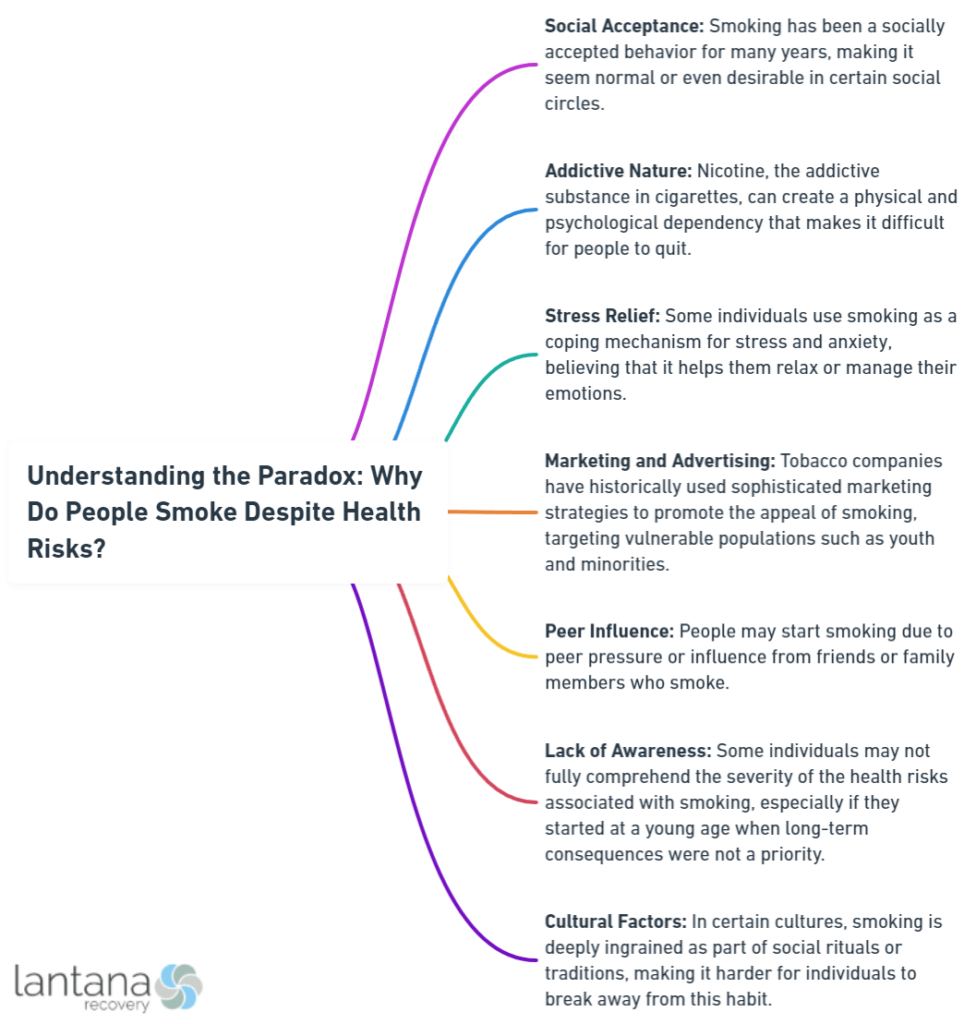Why do people smoke, despite knowing it’s dangerous? From a yearning for acceptance to stress relief, and the undeniable power of addiction – these forces can entice individuals into tobacco’s trap. Throughout this article, we’ll dissect these reasons, shedding light on the complex motivations behind smoking and the industry that profits from this habit. Stay tuned for insights that go beyond the smoke.
Key Takeaways
- The motivations for smoking include social factors like peer pressure, stress relief, and rebellion, with beginnings often rooted in adolescence, leading to long-term addiction and identity formation.
- Nicotine addiction, a key factor in continued smoking, entails physical dependence, emotional and psychological challenges, and difficult withdrawal symptoms which support services and medications can help to address.
- Tobacco industry tactics such as targeted advertising, strategic product placement, and the promotion of e-cigarettes to youth, maintain smoking rates, which public health interventions and policy changes aim to counteract.
The Lure of Smoking: Unraveling the Reasons

People have various compelling reasons to light up their first cigarette. The siren call of tobacco is not a singular tune but a chorus of influences, each with its unique pull. From the teenage need for peer acceptance to the adult’s cry for stress relief or a statement of rebellion, the paths to smoking are many, and they often converge on a road paved with addiction and dependence. Nearly nine out of ten adult smokers ignited this path before they turned 18, signifying that the roots of tobacco use often entangle young hearts and minds, and extend their hold well into adulthood.
The journey begins with the social dynamics of adolescence, where the need to fit in can weigh heavily on young shoulders. Friends, media, and the world at large broadcast a mixed signal where smoking oscillates between a rite of passage and a risky dalliance. Peer pressure, that potent force, can tip the scales, leading many to smoke their first cigarette in a bid for social acceptance or under the weight of a dare. As we navigate through the thickets of youth, the lures of smoking reveal themselves, each capturing different souls for similar reasons.
Peer Pressure and Social Acceptance
High school corridors and college campuses are fertile grounds for developing lifelong habits. Adolescent decisions to smoke are heavily swayed by their social circles; if friends and family members puff away, it’s all too easy for young people to follow suit. The transition to a new school or a fresh group of friends can significantly amplify the odds of an adolescent reaching for a cigarette. It’s not simply a matter of choice, but a dance with social conformity, where the steps are often learned from those who are closest.
The role of media representation and the ease of access to cigarettes only fan the flames of this behavior, making smoking seem like a ubiquitous and somewhat innocuous part of growing up. To a young mind, the rituals of smoking—flicking the lighter, the graceful exhalation of smoke—can appear glamorous, disguising the harsh truth of addiction that lurks beneath.

Stress Relief and Self-Medication
Many fall into the trap of believing that smoking offers relief in a world fraught with stressors. Yet, this is a mirage, as the relief provided is fleeting and, in reality, only serves to quell nicotine withdrawal, not the stress itself. High school students and individuals facing economic hardships often turn to cigarettes as a crutch, a way to self-medicate against life’s pressures, influenced by the normalization of smoking in their environments.
There are healthier shores to seek solace upon. Here are some sustainable, healthy alternatives to help you stop smoking:
- Meditation
- Exercise
- A balanced diet
- Strong social support
These alternatives offer long-term sanctuary without the harmful effects of tobacco. Recognizing smoking for the harmful coping tactic that it is and advocating for these alternatives can help stem the tide of smoking prevalence and bolster well-being.
Rebellion and Identity Formation
For some, the act of smoking is a flag raised in defiance, a symbol of rebellion against the constraints of society and the rules laid down by figures of authority. Adolescents, navigating the turbulent waters of identity formation, may adopt smoking as an emblem of their detachment or discontent. This is not a passing phase for many; as the identity of ‘smoker’ takes root, the likelihood of increasing their smoking frequency grows, cementing a habit that can persist through the years.
A smoker’s identity, once established, is a fortress that proves difficult to dismantle. The transition from experimental puffs to a regular smoking schedule is often fortified by a sense of belonging to a smoking culture, an attachment that can be both defiant and self-defining. For the young rebel, cigarettes may be a companion in their narrative of resistance, but they also can become a shackle from which escape requires more than just a change of heart.
Alcohol Rehab in South Carolina
When seeking alcohol rehab in South Carolina, individuals have various options tailored to their specific needs. South Carolina offers a range of treatment facilities and programs aimed at helping individuals overcome alcohol addiction. These facilities often provide personalized treatment plans, including therapy sessions, support groups, and medical assistance to address both the physical and psychological aspects of addiction. Additionally, many alcohol rehab centers in South Carolina emphasize holistic approaches, incorporating activities like yoga, meditation, and art therapy to promote overall well-being and recovery. Whether in urban centers or more rural areas, individuals seeking alcohol rehab in South Carolina can find supportive environments designed to facilitate their journey towards sobriety.
The Power of Nicotine: Addiction and Dependence

Nicotine addiction alters both the body and mind to promote dependence, much like a chameleon changing its colors. This addictive agent weaves itself through various organ systems, bringing a mix of physiological and pathological effects that ensnare the smoker in a relentless cycle of craving and satisfaction. Nicotine’s journey from a puff of smoke to the brain’s receptors is swift, and its impact is profound, creating a hard habit that binds the smoker to the cigarette with a force that rivals the pull of drugs like heroin and cocaine.
For most adult smokers, the seeds of addiction were sown in their youth, with the majority having started before they could legally vote. Nicotine’s allure is not limited to its immediate effects; it also triggers changes in the brain that reinforce the behavior associated with its uptake, tightening its grip with each inhalation. As we peel back the layers of nicotine addiction, we reveal a battle waged on multiple fronts, one that challenges the smoker at every turn and complicates their journey to freedom.
Physical Addiction
The physical chains of nicotine addiction are forged rapidly, with nicotine reaching the brain within mere seconds of inhalation. It binds to receptors, sparking a release of dopamine that sings a siren song of pleasure and reward, initiating a pattern of addiction akin to other substances of misuse. This is not a simple, singular act—it’s a complex ballet of biological processes that lead to various physical effects, from the stimulation of the central nervous system to the suppression of appetite.
Adolescents are particularly vulnerable; those who begin smoking early demonstrate an increased risk for developing a more severe addiction compared to those who start later in life. The longer the exposure, the harder the habit becomes to break, and the greater the physical addiction that takes hold, making the process of quitting a formidable challenge that goes beyond just willpower.
Emotional and Psychological Dependence
Nicotine addiction manifests not only physically, but it also deeply impacts the mind. Nicotine stimulates the brain’s reward center, offering brief moments of mood elevation and cognitive enhancement that can become addictive. This chronic stimulation leads to the desensitization of neurons, fostering cravings that fuel the addiction cycle.
The emotional and psychological dependence on smoking is further compounded by the conditioned behaviors and triggers that smokers develop over time, linking the act of smoking to specific situations and states of mind. From the social smoker who believes their habit is restricted to certain contexts to the individual using cigarettes as a means of mood regulation, the emotional web of dependence is complex and multifaceted.
Attempting to quit smoking confronts this web, unleashing a cycle of cravings and urges that underscore the power and persistence of nicotine addiction.
Withdrawal Symptoms and Relapse
When the smoke clears and the smoker attempts to break free, nicotine withdrawal rears its head, manifesting in a myriad of nicotine withdrawal symptoms that range from:
- irritability
- anxiety
- difficulty concentrating
- headaches
These symptoms are a testament to the changes that nicotine has wrought on the brain, convincing the individual that they need nicotine to feel normal. Navigating the treacherous waters of withdrawal requires more than just determination; it often necessitates the aid of nicotine replacement therapy or medications to manage cravings and symptoms.
Yet, even with support, the journey to quitting is not a straight path—it’s marked by the potential for relapse, where familiar routines and emotional triggers can lure the smoker back to their old habits. Financial strains, too, can weaken resolve, particularly among low-income smokers. However, each stumble is not the end; it’s an opportunity to learn and to strengthen strategies for the next attempt to quit.
Why Do People Abuse Alcohol
“Why do people abuse alcohol?” is a question often pondered, with complex answers stemming from various factors. Firstly, social and cultural influences play a significant role; alcohol consumption is often normalized and even encouraged in many societies, leading individuals to adopt drinking habits from an early age. Additionally, psychological factors such as stress, trauma, and mental health issues can drive individuals to seek solace in alcohol as a coping mechanism. Genetic predispositions also contribute, as some individuals may be more susceptible to developing alcohol use disorders due to their family history. Moreover, environmental factors such as availability and affordability of alcohol can influence patterns of abuse. Lastly, peer pressure and societal expectations can contribute to the initiation and continuation of alcohol abuse among individuals seeking acceptance or belonging within social circles. Understanding these multifaceted reasons is crucial in addressing and preventing alcohol abuse on both individual and societal levels.
Tobacco Industry Tactics: Marketing and Manipulation

The tobacco industry, a cunning adversary, wields well-crafted campaigns and strategies to attract and retain smokers. Advertising is the spearhead of their efforts, painting smoking in hues of glamour, rebellion, and freedom, capturing the imagination and influencing identity. They wield accessibility like a shield, making tobacco products easily available to facilitate both the initiation and continuation of smoking, while the allure of tobacco smoke further entices consumers.
The industry’s tactics are not confined to the physical world—visibility is a key weapon in their arsenal. Cigarettes and tobacco products marketed with eye-catching displays and strategic placements are a constant reminder of their presence, beckoning new and old smokers alike.
Advertising Strategies
The tobacco industry’s advertising strategies are steeped in history, with campaigns like the ‘Torches of Freedom’ linking smoking to women’s liberation and independence. The image of smoking as a symbol of rebellious independence has been carefully cultivated, influencing the formation of smoker identities that align with notions of glamour, seduction, and allure.
Even today, manufacturers of tobacco and vaping products continue to engage younger demographics, targeting high school and college students with scholarships and discussions that tout the supposed benefits of vaping. These tactics not only distort perceptions of smoking’s harms but also plant seeds that can grow into lifelong habits.
Accessibility and Visibility
The tobacco industry expertly markets their products to ensure maximum accessibility and visibility. Some of their tactics include:
- Power walls and digital displays that turn tobacco products into focal points, impossible to ignore
- Strategically placing tobacco vending machines near schools
- Selling single sticks of cigarettes
- Distributing free samples at youth-centric events
These tactics are insidious and lower the barriers for the young to start smoking.
Online sales present another avenue for the industry to extend its reach, where age verification becomes a mere formality, often bypassed, allowing minors unfettered access to nicotine and tobacco products. The web of accessibility is wide and tangled, designed to snare new users and hold them tight in the grip of tobacco use.
E-cigarettes and Vaping Devices
E-cigarettes and vaping devices have introduced a new dimension to the tobacco industry’s efforts to attract new users. Marketed as sleek, high-tech lifestyle products, these devices have struck a chord with younger audiences, thanks to their minimalist designs and aggressive social media presence. The astonishing variety of flavors—over 15,000, including those like cotton candy and gummy bear—lures in youth with a lessened perception of harm.
E-cigarettes have become the most common tobacco product among U.S. youth, a trend fueled by their ease of use, affordability, and the illusion of being a safer alternative to traditional cigarettes. Devices that mimic everyday items, such as USB flash drives, offer concealability and ease of use, further contributing to their popularity and spread among students. The industry’s tactics are cunning, but the consequences are real—creating a new generation of nicotine addicts, often without their full awareness of the risks involved.
Overcoming Barriers: Effective Strategies for Quitting Smoking

Each individual’s journey to quit smoking is personal and challenging, taking different forms for different people. Whether it’s choosing to quit abruptly or tapering off gradually, utilizing support groups, or employing other methods, the road to smoking cessation is a path paved with determination and the support of effective strategies. The combined forces of prescription medication and behavioral support can significantly increase the chances of a successful quit attempt, offering a lifeline to those looking to break free from nicotine’s hold.
The benefits of quitting smoking are manifold, including:
- Reduced stress, anxiety, and depression
- Improved physical health
- Fresher breath
- Healthier bank balance
Creating smoke-free environments and leveraging technology, such as smartphone applications, can also provide crucial support, helping individuals navigate the smoking cessation journey with greater resolve.
Nicotine Replacement Therapy
Nicotine Replacement Therapy (NRT) serves as a fundamental component of smoking cessation strategies. By providing lower doses of nicotine without the toxins present in smoke, NRT helps to alleviate cravings and ease the discomfort of withdrawal symptoms. NRT is available in various forms, including:
- Gum
- Patches
- Inhalers
- Lozenges
- Nasal sprays
These different forms of NRT cater to different preferences, allowing individuals to choose the method that best fits their lifestyle and smoking habits.
For those seeking a steady release of nicotine, patches applied to the skin can be effective, while gum and lozenges offer more control over dosage and are particularly useful for a gradual weaning off nicotine. Inhalers and nasal sprays can act quickly to combat intense cravings, though they may cause irritation for some users. While side effects like headaches and sleep disturbances may occur, these can often be managed by adjusting the dosage, always under the guidance of healthcare professionals.
Behavioral and Psychological Support
In the quest to quit smoking, behavioral and psychological support services play an essential role. Counseling, whether it’s one-on-one, group-based, or even over the phone, can provide much-needed support, employing techniques such as Cognitive-Behavioral Therapy (CBT) and problem-solving training. The involvement of family, friends, and healthcare providers can significantly enhance the effectiveness of these strategies, offering a network of support that can sustain individuals through the ups and downs of quitting.
For smokers with mental health conditions, additional time and specialized monitoring of medications may be necessary, as these individuals often face a higher level of nicotine dependency and more severe withdrawal symptoms. With the advent of digital tools like web-based programs and mobile apps, along with motivational interviewing and structured approaches like the ‘Five R’s’ system, smokers now have access to a broad array of resources to aid in their cessation efforts.
Some of these resources include:
- Web-based programs
- Mobile apps
- Motivational interviewing
- The ‘Five R’s’ system
These tools can provide support and guidance to smokers with mental health conditions who are trying to quit smoking.
Medications and Alternative Treatments
Smoking cessation medications like Varenicline and Bupropion SR provide more options for those looking to overcome nicotine addiction. Clinical trials have shown that Varenicline, in particular, is one of the most effective treatments for reducing cravings and withdrawal symptoms, providing a significant boost to the quitting process.
While pharmacotherapy can be a critical component of a successful quit attempt, alternative treatments like hypnosis and acupuncture have also garnered interest, although their efficacy needs further research to be fully understood. Hypnotherapy, for example, is being integrated into some smoking cessation programs as a way to alter the smoker’s mindset and diminish the appeal of cigarettes.
Mindfulness training is yet another promising approach that is being explored, focusing on increasing individual awareness and control over tobacco cravings.
Can You Drive with Medical Marijuanas?
The question of whether one can drive with medical marijuanas is complex and highly dependent on various factors. Firstly, it’s crucial to understand that medical marijuana, like any medication, can impair cognitive and motor functions. Therefore, operating a vehicle under the influence of medical marijuana can pose significant risks to both the individual and others on the road. Laws regarding driving under the influence of marijuana, whether for medical or recreational purposes, vary by jurisdiction. However, many places have strict regulations and penalties for driving while impaired by any substance, including medical marijuana. It’s essential for individuals using medical marijuana to familiarize themselves with their local laws and, most importantly, prioritize safety by refraining from driving if they feel impaired in any way. Consulting with a healthcare professional about the potential effects of medical marijuana on driving ability is also advisable to ensure responsible and safe usage.
The Impact of Socioeconomic Factors on Smoking Behavior

Even though lighting a cigarette appears to be a personal choice, it’s often driven by a myriad of socioeconomic factors. Disadvantaged populations, including those in:
- rural areas
- military veterans
- LGBTQ+ individuals
- those with lower levels of education
- individuals below the poverty threshold
Face higher smoking rates than the general population. These factors are not just statistical footnotes; they are real-world smoking leads that can dictate who starts to smoke cigarettes, how heavily they smoke, and the challenges they face when they decide to quit.
The high smoking rates within certain demographics can be alarming. For instance, smoking rates among LGBTQ+ individuals stand significantly higher than those identifying as straight, indicating the need for targeted public health strategies that take these disparities into account. Health inequalities, such as those seen in cancer incidence and outcomes, are often exacerbated by the higher levels of nicotine intake and dependence found among poorer smokers, leading to increased health risks.
Disadvantaged Populations and Higher Smoking Rates
There’s an indisputable link between socioeconomic disadvantage and elevated smoking rates. Those without the social and economic buffers that come with higher education levels and greater income are more likely to smoke and to smoke more heavily. This vulnerability extends to various groups, including:
- Adults in rural communities
- Veterans
- LGBTQ+ individuals
- Indigenous peoples
All of whom, including most smokers, have smoking rates that exceed those of their more advantaged counterparts.
Mental health conditions, including mental health problems, also play a significant role in smoking behavior. Individuals grappling with anxiety, depression, or other mental health disorders are more likely to use tobacco as a coping mechanism, further entrenching the habit. Recognizing the need for comprehensive support that addresses these underlying issues is crucial in developing effective smoking cessation programs that can reach and resonate with these populations.
Access to Resources and Support Services
Many low-income smokers face the dual challenges of quitting smoking and a lack of access to resources and support services. Some perceive cessation assistance as unnecessary or ineffective, viewing it as a last resort rather than a viable first step. Despite increased engagement with specialized interventions like quitlines, this does not always translate into higher cessation rates, highlighting a disconnect between availability and effective use of support services.
The immediate social and financial pressures faced by low-income individuals often overshadow the long-term goal of quitting smoking. These day-to-day concerns can derail cessation efforts, underscoring the need for support systems that address both the smoking habit and the socioeconomic factors that perpetuate it.
Government Policies and Public Health Interventions
Government policies and public health interventions can significantly influence smoking behavior and help address health inequalities. Some examples of effective policies and interventions include:
- Smoke-free laws, which have been linked to reductions in hospitalizations for several diseases and have wide-reaching health benefits
- Tobacco taxes, which have been shown to reduce smoking rates, especially among young people and low-income populations
- Comprehensive tobacco control programs, which combine multiple strategies such as public education campaigns, cessation support, and enforcement of tobacco control laws
- Restrictions on tobacco advertising and promotion, which can reduce the appeal of smoking, especially among young people
These policies and interventions have the potential to benefit different racial and ethnic groups equally and contribute to the reduction of health disparities.
The implementation of comprehensive smoke-free laws not only impacts public spaces but also encourages the establishment of smoke-free environments in private settings, like homes. Such policies can help foster a culture of health and well-being, promoting smoking cessation across diverse communities. To effectively reduce smoking in future generations, approaches that directly tackle the challenges of poverty and provide equitable access to cessation resources are essential.
Summary
Through the haze of smoke, a complex picture emerges—one where the act of smoking intertwines with the fabric of society, influenced by peer pressure, stress, rebellion, and identity. The powerful addiction to nicotine presents a formidable challenge to those who wish to quit, exacerbated by the tobacco industry’s strategic marketing and accessibility tactics. Yet, amidst these challenges, effective strategies for smoking cessation offer hope, from nicotine replacement therapy to behavioral support and government interventions. This blog post has illuminated the multifaceted nature of smoking behavior, the barriers to quitting, and the paths available to those seeking to escape the grip of tobacco, ultimately underscoring the importance of a comprehensive, empathetic approach to smoking cessation.
Frequently Asked Questions
What does smoking actually do?
Smoking can lead to a decrease in oxygen levels in the blood, potentially damaging the heart muscles and blood vessels. Additionally, it can cause lung diseases like COPD and increase the risk of lung cancer.
How can I be a healthy smoker?
Unfortunately, there is no way to be a healthy smoker. Smoking poses serious health risks, and the best option for your well-being is to quit smoking altogether. Regular exercise, a healthy diet, and managing stress levels do contribute to overall health, but they cannot fully counteract the harmful effects of smoking.
Why are people addicted to smoking?
People become addicted to smoking due to the highly addictive nature of nicotine, which can cause immediate changes in the brain and create cravings for more. The release of dopamine in the brain from nicotine leads to a temporary feeling of pleasure, making it very difficult to quit.
How does nicotine lead to addiction?
Nicotine leads to addiction because it rapidly reaches the brain and activates receptors that release dopamine, a neurotransmitter associated with pleasure and reward. This makes quitting challenging as the body and mind become dependent, leading to withdrawal symptoms when attempting to stop.
What strategies are effective in helping people quit smoking?
Combining strategies like nicotine replacement therapy, counseling, and creating smoke-free environments is often the most effective approach for quitting smoking. Alternative treatments such as hypnosis or acupuncture, along with digital tools like smartphone apps, can also support the quitting process.









